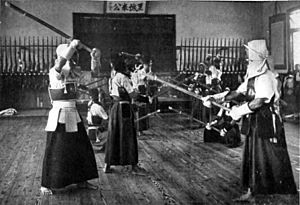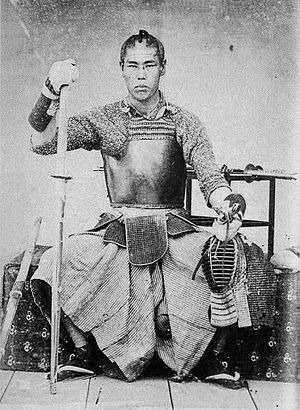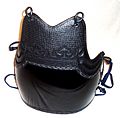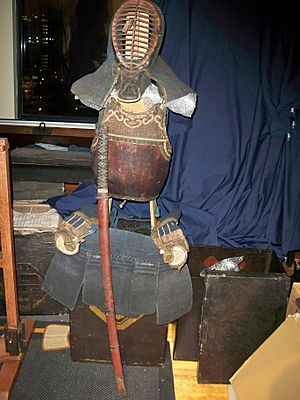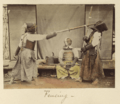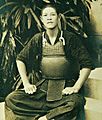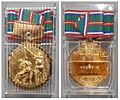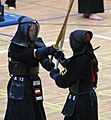Kendo facts for kids
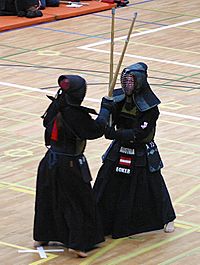 |
|
| Focus | Weaponry |
|---|---|
| Hardness | Full-contact |
| Country of origin | |
| Parenthood | kenjutsu |
| Olympic sport | No |
Kendo is a traditional Japanese martial art. It comes from swordsmanship, which is called kenjutsu. Kendo uses bamboo swords, known as shinai, and special protective armor, called bōgu.
Today, many people practice Kendo in Japan and all over the world. It mixes martial arts training with exciting physical sport. The All Japan Kendo Federation believes there are 1.66 million Kendo players in Japan. Worldwide, over 6 million people practice Kendo. Kendo helps train your mind and body by following the rules of the katana, a Japanese sword.
Contents
Kendo's History
Japanese swordsmen started schools for kenjutsu many centuries ago. These schools are the base for how Kendo is practiced today. The formal Kendo exercises, called kata, were created hundreds of years ago. Warriors used them to practice kenjutsu. People still study these kata today, but in a slightly changed way.
How Kendo Gear Started
The idea of using bamboo practice swords (shinai) and armor (bōgu) for sword training came from Naganuma Shirōzaemon Kunisato. This happened between 1711 and 1715.
In 1920, a group called the DNBK (Dai Nippon Butoku Kai) changed the name of the sport. It used to be called gekiken, meaning "hitting sword." They renamed it kendō, which means "the way of the sword."
Kendo After World War II
After World War II, Kendo and other martial arts were banned in Japan in 1946. The DNBK group was also shut down. Kendo was allowed back into schools in 1950. At first, it was called "shinai competition." Then, in 1952, it was officially called Kendo again.
The All Japan Kendo Federation (AJKF or ZNKR) started in 1952. This was right after Japan became independent again and the ban on martial arts was lifted. The AJKF saw Kendo not just as a martial art, but as an educational sport. It is still practiced this way today.
The International Kendo Federation (FIK) was created in April 1970. It is a worldwide group for national and regional Kendo federations. It helps promote Kendo, iaido, and jodo around the world.
Why People Practice Kendo
Kendo has many goals for those who practice it:
- To train your mind and body.
- To build a strong and energetic spirit.
- To get better at Kendo through correct and strict training.
- To respect good manners and honor.
- To be honest and sincere with others.
- To always work on improving yourself.
- To love your country and community.
- To help develop culture.
- To encourage peace and success for everyone.
Kendo Gear and Clothing
The shinai is a bamboo sword that looks like a Japanese sword (a katana). It is made of four bamboo pieces held together by leather. There are also modern shinai made from carbon fiber. Kendo players also use hard wooden swords, called bokutō, to practice kata.
Kendo players wear special armor called bogu. This armor includes a helmet (men), a chest protector (do), a waist protector (tare), and special gloves (kote). Under the armor, they wear a jacket (kendogi or keikogi) and wide, split trousers called hakama. A cotton towel, called a tenugui, is wrapped around the head under the helmet. This helps soak up sweat and makes the helmet fit better.
How Kendo is Practiced Today
Kendo training can be quite loud compared to other martial arts. This is because kendōka (Kendo players) shout loudly when they strike. This shout shows their fighting spirit. Also, when they strike, kendōka stomp their front foot on the ground.
Like some other martial arts, kendōka train and fight without shoes. Kendo is best practiced in a special training hall called a dōjō. However, regular sports halls or other places with a clean, springy wooden floor are often used.
Kendo Techniques and Matches
Kendo techniques involve both strikes and thrusts. Players can only strike specific areas that are protected by armor. These areas are the wrists, head, or body.
Kendo competitions usually involve a three-point match. The first player to score two points wins the match. If time runs out and only one player has a point, that player wins.
If there's a tie, there are a few ways to decide the winner:
- Hiki-wake: The match is called a draw.
- Enchō: The match continues until one player scores a point.
- Hantei: The referees decide who wins.
The World Kendo Championships happen every three years since 1970. The International Kendo Federation (FIK) organizes them with help from the host country. The European championship is held every year, except when there's a world championship. Kendo is also part of the World Combat Games.
Related pages
Images for kids
-
Kendo in the early Meiji period (1873)
-
Lee Teng-hui, who later became President of Republic of China (Taiwan), wearing Kendo armor as a junior high school student in Japanese Taiwan.
-
Kendo "Swordsmanship" by Yoshitoshi (1873)
See also
 In Spanish: Kendo para niños
In Spanish: Kendo para niños


